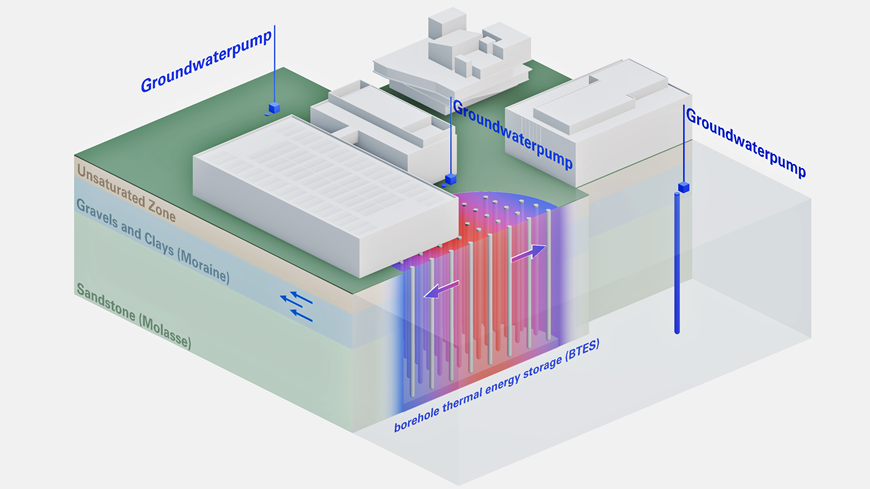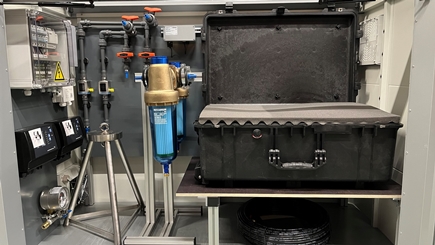Impact of borehole thermal energy storage on groundwater
Oasis of wellbeing or source of stress?
In a recently launched project, the aquatic research institute Eawag is investigating, together with Empa on the joint campus in Dübendorf, how the use of borehole thermal energy storage (BTES) affects the surrounding soil, the groundwater and the microorganisms living in it.

In winter, conventional geothermal heat pumps draw heat from the ground to heat buildings. The borehole heat accumulators installed on the Empa and Eawag campus are geothermal probes that can not only draw heat to the surface in winter, but also store summer heat underground so that it is available in the colder season. Temperatures of up to 65 degrees Celsius are supplied to the storage system. As a result, temperatures of up to 50 degrees Celsius are reached locally in the ground.
So far, however, little is known about how the subsurface reacts to these high-temperatures. The regular heating and cooling of the probes at depths of up to 100 meters can affect the chemical components in the groundwater as well as the microbial communities in soil and water. Exactly how and to what extent is now being investigated as part of the ARTS (Aquifer Reaction to Thermal Storage) research project at the aquatic research institute Eawag.

A unique setup

144 geothermal probes were “sunk” on the Dübendorf campus. They run up to 100 meters deep and converge in a basement next to the new car park. The geothermal probe field is being used by Empa's ehub (“Energy Hub”) team to investigate experimental designs of such storage systems and the interaction with other heat sources. Initial results show that it can make a valuable contribution to the decarbonization of a local energy system.
Three new holes were recently drilled into the ground: ART’s groundwater observation points. Over the next three years, water samples from underground will be pumped to the surface to provide information on how the microbiology of the environment reacts to the probes and to what extent the chemical composition of the groundwater is affected.
The researchers use five pumps to extract groundwater samples from the three boreholes before, during and after it comes into contact with the geothermal probes. In the first few years of the project, only two of the three monitoring stations will be relevant, as comparisons can be made just a few months after the probes are commissioned. However, it may take several years for the groundwater from the immediate vicinity of the probes to reach the third station further away – that’s how slowly the groundwater flows through the subsurface.
Miniature mass spectrometer

The aim of the project is to gain insights into the reactions triggered by this type of heat storage in the groundwater. This includes not only hydrogeochemistry and microbiology, but also the analysis of gases such as oxygen, methane or carbon dioxide produced by the effects of heat in the ground. Such gases are mainly consumed and produced by bacteria underground – depending on the effects of heat and cold. For this purpose, the water in the pump flows into the GE-MIMS mass spectrometer (also known as miniRUEDI) developed at Eawag. “For the next three years, miniRUEDI devices will measure the dissolved gases in the groundwater every hour, while 2.4 liters of water are pumped through the mass spectrometer every minute,” explains Joaquin Jimenez-Martinez, head of the project and researcher in Eawag’s Water and Drinking Water Department.
The sampled water is also regularly analyzed in the laboratory by researchers from Eawag’s Environmental Microbiology and Aquatic Ecology Departments. They focus on the question of how microbial diversity changes under the influence of temperatures of this magnitude. DNA traces (known as eDNA) can also be used to determine which organisms populate the groundwater and whether their numbers and distribution change as a result of the geothermal probes.
Great interest from the federal government and cantons
Switzerland already has the highest density of geothermal probes per unit area in the whole of Europe, which is why the project is attracting a great deal of interest from the cantons and the federal government. The demand for new possibilities for energy generation and seasonal storage has also increased as part of the energy transition. The effects of temperature input on the groundwater as an overall system are also of interest. ARTS is therefore supported by the Swiss Federal Office of Energy as well as the Cantons of Zurich, Aargau, Thurgau, Zug and Geneva and is run in cooperation with Empa and Eawag. Employees from the environmental offices of Zurich and Thurgau also contribute to the understanding of hydrogeological questions. Collaboration at this scale is uncommon and the speed at which the project was developed is unprecedented. “It only took ten months from the initial idea in a corridor at Eawag to the drilling of the holes on campus for the sensors,” says Jimenez-Martinez. This shows how urgent the issue is.
Prof. Dr. Matthias Sulzer
Empa, Urban Energy Systems
Phone +41 58 765 47 29
Prof. Dr. Joaquin Jimenez-Martinez
Eawag, Water and Drinking Water
Phone +41 58 765 54 75
-
Share






